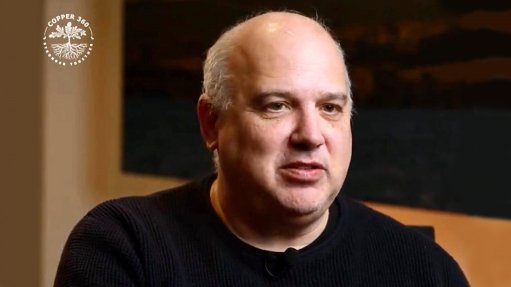Flawed legislation stymieing South Africa’s diamond polishing efforts – Blom

World Federation of Diamond Bourses president Ernest Blom discusses the South African diamond industry and the state Diamond Trade. Camerawork: Nicholas Boyd. Editing: Darlene Creamer.
While the idea behind the State Diamond Trader (SDT) is noble, the legislation that paved the way for its establishment is flawed, and this has led to beneficiators not receiving the types of diamonds that can be polished economically in South Africa, says World Federation of Diamond Bourses president Ernest Blom.
“I believe that the problems relating to the SDT are a result of too little consultation before the legislation was promulgated. Had government come to industry with its ideas beforehand, we would perhaps have given them a different outlook,” Blom tells Mining Weekly.
However, SDT CEO Futhi Zikalala is adamant that the entity does support the local beneficiation of diamonds through ensuring supply.
“Without the SDT, producers would not provide 10% of their diamonds for the local industry. Whatever might be said about the kind of supply we provide and other issues with the trader, we are able to get diamonds from mining companies and are supplying these to local manufacturers,” she tells Mining Weekly.
Zikalala points out that, while the SDT’s footprint with regard to the entire diamond industry has not been large enough, it has undertaken activities to support its clients, including facilitating access to funding and sponsoring stands at local trade shows.
She adds that the SDT is aiming to increase its footprint over the next year and grow the diamond industry locally and internationally.
“We are now looking . . . at how we can support the entire industry and not only our clients. This calls for us to work with other stakeholders, including industry players, on finding ways to improve the industry,” she says, adding that exciting developments are planned for the next year.
“We have learnt many lessons during the five years that we have been in operation and these will help us in shaping our next five years and beyond.”
The SDT is required by legislation to buy run-of-mine (RoM) production, or what is known as a representative sample, from mining companies, which means that all types of diamonds – ranging from industrial to gem-quality stones – are bought.
“The SDT is required to buy RoM production from mining companies and, as it will not be feasible to sell those diamonds selectively, we have to sell RoM production to local diamond cutters and polishers,” she explains.
Blom points out that this creates a problem, as certain diamonds cannot be polished in South Africa and, therefore, have to be sold on by the manufacturer.
“In South Africa, we cannot polish industrial or near-gem-quality diamonds. We can only polish gem-quality diamonds of a certain size or larger.
“Therefore, the legal requirement that the SDT has to buy RoM production leads to manufacturers not being able to polish 90% of the volume of the diamonds bought from the SDT,” Blom explains.
However, one also has to take the needs of the diamond mining companies into account, he says.
“Producers ideally like to sell total RoM, as it is easier to get fair market value for a mixture of industrial and gem-quality diamonds, which creates a problem for the SDT and legislators.
“On the one hand, the local beneficiators would prefer to have access to gem-quality diamonds only, but, on the other hand, the producers demand fair market value for their products, to which they are entitled,” he says.
“It is a fine balancing act. Speaking as a beneficiator, I would want the legislation changed; however, if I were a mining company, I would feel that changing the legislation would be unfair to me,” Blom explains.
Therefore, careful consultation with all parties would have to take place before considering changing the legislation, he adds.
Mohseen Moosa, former CEO of State-backed and now liquidated diamond beneficiation firm African Romance, told Mining Weekly in June last year that the SDT had not been able to supply polishable rough diamonds to South African producers at competitive prices.
However, Blom and Zikalala do not believe this is the case.
“Rough diamonds have an international price and the SDT buys at that price. Therefore, I do not believe that it is a question of not being able to buy at the correct price, but rather that the SDT is obliged to buy diamonds that beneficiators do not necessarily want to buy,” Blom says.
Zikalala adds that the problem is that producers expect lower prices from the SDT, as it is a State-owned entity.
“However, we cannot sell diamonds at prices lower than the prices at which we buy them. We make a profit of only about 4% profit, which is confirmed in our yearly reports, and we do not hide the fact that we have to buy and sell RoM production,” she says.
Diamond Beneficiation in South Africa
Historically, most of Africa’s commodities, including diamonds, have been colonised and, therefore, it is the ambition of African governments, in particular South Africa, to beneficiate, Blom explains.
“The importance of beneficiation is extremely high and I think that it is something that is correct and which we subscribe to.
“However, beneficiation has to go hand in hand with the sustainable development of the particular sector in which it is taking place. We need to ensure that whatever we do in terms of beneficiation is sustainable,” he says.
Blom adds that, while the intentions surrounding beneficiation are good, the diamond sector is shrinking dramatically.
“Less than 20 years ago, South Africa had about 4 500 diamond polishers but, currently, there are not more than 600, which highlights the importance of government sitting down with the industry to work out the way forward to reverse this trend.”
The playing field for diamond producers, comprising South Africa and its competitors, which include India, China and other Asian countries, has to be levelled.
“We need to cut out the unnecessary red tape and work towards creating a workforce that is suitably trained to compete with the rest of the world,” he says.
Blom points out that diamonds are a commodity that is easily transportable, which increases the need to ensure that South African diamonds are polished here to the same standard as those polished elsewhere or “they will leave the country”.
Zikalala adds that the South African diamond industry is financially constrained.
“It is easy to state that we want to promote an industry, but that cannot be done without funding, which is something that will have to be addressed,” she says.
The diamond industry is also capital intensive. While a diamond polisher’s machinery costs will not be as high as the machinery costs in other industries, the cost of the raw material is much higher, impacting significantly on the value-added tax (Vat) paid by the polisher.
“For example, should a diamond polisher’s capital expenditure comprise 10% for machinery and 90% for raw material, the polisher will have to pay Vat on that 90%, which makes it expensive to finance and it effectively amounts to 14% out of the company’s account that could have been used to buy diamonds,” he explains.
This is a major concern and the industry has often asked for the Vat to be zero-rated, but to no avail, he states.
“Further, we have also asked for dollar accounts so that we can actively trade in dollars,” he says.
Currently, the diamond industry worldwide is dollar-based. Therefore, when rough or polished diamonds are bought and sold in South Africa, the exchange rate plays a major role.
While this is not a problem if the local currency is stable, the rand often fluctuates, leading to major losses for the diamond beneficiators.
Comments
Press Office
Announcements
What's On
Subscribe to improve your user experience...
Option 1 (equivalent of R125 a month):
Receive a weekly copy of Creamer Media's Engineering News & Mining Weekly magazine
(print copy for those in South Africa and e-magazine for those outside of South Africa)
Receive daily email newsletters
Access to full search results
Access archive of magazine back copies
Access to Projects in Progress
Access to ONE Research Report of your choice in PDF format
Option 2 (equivalent of R375 a month):
All benefits from Option 1
PLUS
Access to Creamer Media's Research Channel Africa for ALL Research Reports, in PDF format, on various industrial and mining sectors
including Electricity; Water; Energy Transition; Hydrogen; Roads, Rail and Ports; Coal; Gold; Platinum; Battery Metals; etc.
Already a subscriber?
Forgotten your password?
Receive weekly copy of Creamer Media's Engineering News & Mining Weekly magazine (print copy for those in South Africa and e-magazine for those outside of South Africa)
➕
Recieve daily email newsletters
➕
Access to full search results
➕
Access archive of magazine back copies
➕
Access to Projects in Progress
➕
Access to ONE Research Report of your choice in PDF format
RESEARCH CHANNEL AFRICA
R4500 (equivalent of R375 a month)
SUBSCRIBEAll benefits from Option 1
➕
Access to Creamer Media's Research Channel Africa for ALL Research Reports on various industrial and mining sectors, in PDF format, including on:
Electricity
➕
Water
➕
Energy Transition
➕
Hydrogen
➕
Roads, Rail and Ports
➕
Coal
➕
Gold
➕
Platinum
➕
Battery Metals
➕
etc.
Receive all benefits from Option 1 or Option 2 delivered to numerous people at your company
➕
Multiple User names and Passwords for simultaneous log-ins
➕
Intranet integration access to all in your organisation



















